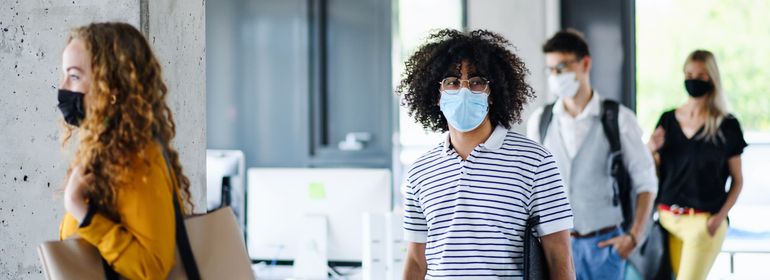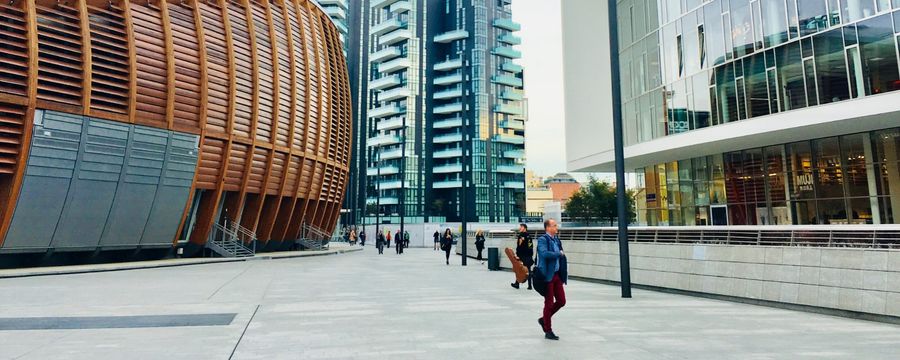Supporters have called facial recognition “the most natural of all biometric measurements” and say the technology is highly accurate, with “vanishingly small differences in their rates of false-positive or false-negative readings across demographic groups.” Critics, by contrast, argue that it’s “tech’s biggest mistake”: It hearkens to the dystopian world of Black Mirror and yields too many false positives — innocent people who are identified as a culprit. So, who is right?
Table of contents
- What Is Facial Recognition?
- What Are the Benefits of Facial Recognition Systems?
- Facial Recognition Concerns, Objections, and Drawbacks
- Commonly Asked Questions About Face Recognition
Related Post
- Face Recognition Access Control Systems
- Guide to Face Recognition Access Control Systems
- 3 Privacy Concerns Around Facial Recognition Technology
- Limitations of Face Recognition in Access Control Systems
What Is Facial Recognition?
At its most basic, facial recognition involves identifying or verifying someone using characteristics and features of their face. Various technologies exist, including 3-D, vascular and heat-pattern, and skin texture analysis. In the most prevalent type of facial recognition, algorithms identify certain points on the face, such as the shape of one’s chin, and create a template for that person. It is most accurate when users voluntarily submit their images into a limited database, such as a company network, for a use such as face access control. When the person approaches a facial scanner, their live image is captured and converted into a template, which is then compared to the templates stored in the database. A match enables the user to undertake some activity, such as passing through a door or logging into a computer network.
What Are the Benefits of Facial Recognition Systems?
Safety and Security
Facial recognition technology has been used countless times to identify, interdict, and capture criminal suspects. In 2019, New York police used facial recognition to track down an alleged rapist within 24 hours. It’s used as well for identity documents, at border checks, to identify missing children, to find human trafficking victims, and more. Perhaps its fastest growing application is as part of a facial recognition door access system like Swiftlane.
Convenience
When used in physical or logical access control systems, facial recognition provides a passive, seamless, and frictionless access solution. Users don’t have to worry about forgetting their badge or the keypad combination. They need only pause momentarily at a camera, not stop and insert a hand or finger into a device. It is a completely touchless system when the door is configured to open automatically.
Customer Service
Retailers, theaters, stadiums, and other facilities use facial recognition to tailor the visitor or customer experience and cater to VIPs, such as providing concierge service. It can be used to create smart digital signage and to simplify the checkout process, as is the case in Amazon GO stores.
Healthcare Advances
Researchers at the National Human Genome Research Institute have used facial recognition software to make accurate diagnosis of DiGeorge Syndrome, a chromosomal disorder that causes many health challenges. Researchers compared 156 Latin Americans, Africans, Caucasians, and Asians with DiGeorge Syndrome against others without the ailment. Facial recognition yielded an almost 97% rate of correct diagnosis. Other healthcare applications include an app that makes sure patients take their medication as prescribed. And organizations are using it in the battle against Coronavirus. For example, CLEAR, the company that helps expedite travelers through security in U.S. airports, is rolling out a tool that uses facial recognition to determine whether an employee has Covid and should stay home.
Facial Recognition Concerns, Objections, and Drawbacks
Matching Errors
Accuracy of facial systems wane when the universe of users is unlimited. Consider a retail chain that uses facial recognition to match customers against a database of known shoplifters. As more and more people enter their stores, it becomes more likely that someone will closely resemble a known shoplifter and be wrongly matched. Errors may also come about because of poor images, images captured at a bad angle, and bad lighting.
Privacy Issues
Is facial recognition invading your privacy? Massive data breaches occur regularly, and the prospect of one’s facial image being stolen is unsettling. Last year, for example, U.S. Customs and Border Protection reported that hackers had stolen almost 100,000 photos of travelers. In addition, facial recognition technology can be used to track individuals, and the American Civil Liberties Union warns against its use for “general, suspicionless surveillance systems.”
Misuse of Facial Recognition Technology
Many citizens fear misuse of the technology. In a 2019 Pew survey, half of U.S. adults said they didn’t trust technology companies to use facial recognition data responsibly. Almost 30 percent had similar doubts about law enforcement. And two-thirds didn’t trust the technology in advertisers’ hands. Further, Panda Security points out that many facial recognition databases are public. “This means that any person, even those with malicious intent, can find you on the database and track you down.”
Commonly Asked Questions About Face Recognition
How does face recognition technology work?
Modern face recognition is developed in the fields of machine learning and computer vision. Since 2015, from the resurgence of deep learning, computers have been able to extract information from images at superhuman accuracy. Face recognition technology uses the entire RGB (red, green, blue color model) photo of a person, and runs it through a deep learning (AI) algorithm that processes the image through millions of floating point computations to generate a unique signature of a face. This unique signature is used to compare a user’s photo in the future and to check against existing signatures.
Face recognition vs face identification vs face verification: How do they differ?
Face recognition works by identifying a single person uniquely from a large pool of registered faces. Face Identification or verification mean the same thing. They both involve a 1:1 comparison between two photos of the same person.
Is facial recognition safe?
Physically, facial recognition is completely safe. Scanning causes no damage to the face, and it is not intrusive. Both ordinary and infrared cameras use light frequencies that exist in sunlight, and infrared cameras are similar in strength to a television remote control. It is also touchless, which is a key consideration during the Coronavirus pandemic.
Can facial recognition systems be fooled by photos or video?
A poorly implemented face recognition system can be fooled through spoofing techniques, by holding a photo or video of a person, or by wearing a 3-D mask, which is a security risk. It’s important to use systems that implement anti-spoofing measures.
How do facial recognition systems prevent spoofing?
Any good face recognition systems should implement anti-spoofing measures in order to prevent misuse and unauthorized access to a system. Such measures include face “liveness” detection (such as via blink rate), texture analysis, and user motion (challenge/response) requirements.
Does facial recognition work with face masks?
Face recognition systems utilize the entire geometry of the face and generate a unique signature of the face. Masks prevent high accuracy of face recognition systems, limiting facial analysis to areas of the face that are uncovered. It’s important that face recognition systems only grant access when people take their mask off, otherwise there can be accuracy issues and authorized access issues. While companies are furiously working on technology that can provide reliable results on people wearing masks, those systems are not yet nearly as effective.
Does face recognition work with glasses and sunglasses? What about hats and headbands?
Facial recognition works with high accuracy with most glasses, sunglasses, hats, and headbands. However, if a person is wearing extremely large sunglasses, a tightly pulled-down ballcap, or a combination of hat, glasses, and/or headband, the system may fail to recognize them.
Is facial recognition biased on the basis of race and ethnicity?
Face recognition systems have come under scrutiny for lower accuracies for people of color and various ethnicities. Use of face recognition for criminal watch is problematic, because some of the law enforcement face recognition systems incorrectly classify Black people as criminals. Systems built from a wide array of subjects of different races, ethnicities, and appearances do not suffer problems with lower accuracy.
How do you avoid bias in face recognition systems?
Face recognition accuracy bias can be eliminated by using the following best practices:
- Good training data: It’s important to train the face recognition using diverse faces across genders, age groups, ethnicities, and skin colors.
- Add 3-D recognition: Companies should add 3-D face recognition using 3-D cameras as a second recognition feature.
- High Resolution Images: Face recognition systems should use high resolution images enrollees. Video surveillance cameras that claim face recognition often suffer from poor accuracy, since they utilize low res, high field of view cameras mounted far away on the ceiling or in a distant corner.
Why should you consider using face recognition for access control?
Many an access control company relies on keycards, which can be lost or forgotten — and are often shared, which is an unnerving proposition in a pandemic. Face recognition is used by billions of people due to high accuracy enabled by advances in the field of computer vision. In the Covid era, touchless door entry systems are more important than ever. By using face recognition access control systems like Swiftlane, organizations can now implement frictionless, touchless access to buildings, at events, in schools and at many other venues. This technology provides higher security and frictionless access to end users.
Can face recognition be used for temperature measurement?
At least 15 companies offer terminals — or kiosks — where facial recognition technology measures a person’s body temperature. Some systems can also be used to control access to a facility or area, confirm that the person is wearing a face mask, perform mass screening, enforce social distancing, offer digital messaging, or track bi-directional movement.
In the end, facial recognition is improving rapidly and offers a wide and expanding array of benefits. Used wisely, with proper controls in place to limit sweeping use by law enforcement and corporations, facial recognition is a key element in safety, security, healthcare, and many other fields.
Learn More About Swiftlane Touchless Access Control
We'd love to hear from you! Contact us and we will reach out with more details and info.





